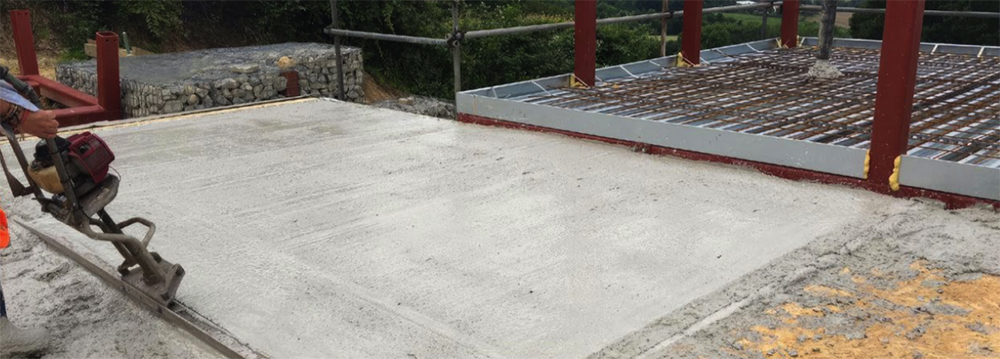Time for designers to think again about going cement free
Contents |
[edit] Cement alternative
It is a fact - alkali-activated cementitious material (AACM) provides a real alternative to Portland Cement (PC). It is a product that delivers CO2e reductions of up to 85% at a time when there is more pressure than ever to reduce damaging emissions – so what is it that is preventing some designers from specifying a proven material with real green credentials?
Could it be that AACMs are not currently covered in the concrete specification Standards EN 206(1) and BS 8500(2)? There is a good reason for that – AACMs are not cement, a material used within concrete which is responsible for 8% of the world’s CO2 emissions. This means that many specifiers are unsure of the best way forward – but that is all about to change.
[edit] Meeting standards
Cemfree, a pioneer in the development of ultra-low carbon cement free products, has produced an extensive designers guide which shows how it is possible to specify AACMs that meet British Standards Institute (BSI) specification document – PAS 8820:2016(3).
The guide is based on extensive commercial use of AACM concrete and durability testing in compliance with the requirements of PAS 8820. The recommendations provided cover compressive strength, concrete cover to reinforcement, binder content for various exposure conditions, concrete strength classes, possible additional measures and much more.
[edit] Specification document
The Cemfree specification document can be downloaded via this link: https://www.cemfree.com and demonstrates why cement-free concrete has been proven to perform equally as well as PC across a range of different applications, a trend which is firing the attention of building owners, specifiers and other construction professionals looking to reduce their carbon footprint.
With growing concerns over its impact on CO2e emissions, the construction industry is looking for more sustainable options. Alkali activated cementitious materials provide an innovative solution to these challenges, but slow-moving industry standards currently stand in the way of widespread AACM adoption.
AACMs are created at room temperature by combining an alkaline solution (this is called the activator) and a non- crystalline aluminosilicate material. The resulting products, such as Cemfree, have a significant environmental advantage over traditional Portland cement. AACMs are an alternative binder to traditional Portland cement and can be used in a wide range of concretes and concrete products.
As the conversation around concrete and construction as a whole, increasingly trends towards carbon neutrality and carbon reduction, AACMs are not only effective practically, but offer a preferable carbon footprint, yet acceptance has been slow.
[edit] Prescribed hesitancy
A reason for the hesitancy to adopt AACMs is believed to be due to the minimum level of Portland cement that is mandated within the relevant standard for concrete manufacture. The British Standards are respected and prescribed, currently leaving few opportunities for using alternatives that don’t fit within them. Against this background it is understandable why some specifiers would wish to be risk-averse and prefer to use the available standards and data to help them make a decision about which materials to use. As a result, this leads to the use of PC even when other, ultra-low-carbon materials would be suited to the project.
For companies such as Cemfree, it is all about challenging these existing standards. At present, for concrete mixes to qualify for the BS EN 8500, they must contain at least 20% Portland cement. As already mentioned, since AACMs are created without PC, this leaves products such as Cemfree unable to fit into any category.
Creating a comprehensive guide is a major step forward in terms of getting more architects to specify AACMs. Most industry experts now believe that this is the ideal time to develop new industry-wide guidance and standards that support innovation and sustainability. By exploring the cement alternatives already on the market, construction professionals can work towards a cleaner, greener industry that works in harmony with the environment. There are numerous effective, ultra-low-carbon materials available that work alongside cement to support the built environment. AACM products can help reduce CO2e emissions, but standards-related barriers currently prevent their use in some building projects across the UK.
[edit] Cemfree Chatham Station
In spite of these reservations Cemfree has already shown that when specifiers are prepared to work with them then it is possible to successfully incorporate ultra- low carbon AACM alternatives into many projects. Chatham Station in Kent which officially opened in January 2023 is just one such example. It was the largest Cemfree Pour for Network Rail when first installed by BAM Nuttall in May 2020. The 300 cubic-metre continuous pour supports the foundation for a new step-free access. The station was the first use of Cemfree on the UK rail network and, by eliminating the use of traditional concrete, saved approximately 62 tonnes of carbon from entering the atmosphere – the equivalent of 230,000 miles in an average-sized diesel car.
Commenting about the project, Huw Jones, BAM Nuttall Divisional Director, Rail said: “By working with Network Rail we gained product approval for this revolutionary product. It means we can continue to deliver vital railway improvements with less impact on the environment. Seeing this product being used on site underlines our commitment to developing innovative sustainable solutions for Britain’s railways and I look forward to seeing other projects making use of it. It has the potential to make a huge contribution towards the reduction of carbon emissions across the construction industry.”
Sarah Borien, Head of Environment & Sustainability Network Rail, agreed, commenting: “This is a great example of how we are working with our supply chain to reduce carbon emissions and contribute to our common sustainability goals. At Network Rail Southern, our sustainability plan includes a number of environmental and social priorities – one is focused on finding sustainable alternatives to our common construction materials. Cemfree concrete has reduced our embodied carbon by 83% in this instance and shows how our capital projects can make simple changes as part of our journey to carbon net-zero.”
BAM is currently investigating further opportunities to make use of cement-free and low cement products across sites in the UK and such was the success of the project that Aaron Lucid from Cemfree, was awarded the title of ICE Carbon Champion by the Institute of Civil Engineers (ICE). The ICE Carbon Champions programme recognises decarbonisation efforts from across the civil engineering community and provides recognition for project owners as well as best practice insights and expertise for the wider industry.
The technology is proven and we now need the ruling Standards authorities to accept that products such as Cemfree are here to stay and offer a real green alternative. They need to be recognised as such, so that the industry can specify and use them with confidence. While cement will always been needed within the industry and will never be fully replaced, architects and other key specifiers should challenge the industry, and reduce embodied carbon across their building projects. A major solution is now available to reduce damaging carbon emissions, but how long do we have to wait before the construction industry finally wakes up?
This article appears in the AT Journal Spring issue 145 as "Time for designers to think again about going cement free" and as written by Cemfree, for further information visit https://www.cemfree.com
--CIAT
[edit] Related articles on Designing Buildings
Featured articles and news
The UK's Modern Industrial Strategy: A 10 year plan
Previous consultation criticism, current key elements and general support with some persisting reservations.
Building Safety Regulator reforms
New roles, new staff and a new fast track service pave the way for a single construction regulator.
Architectural Technologist CPDs and Communications
CIAT CPD… and how you can do it!
Cooling centres and cool spaces
Managing extreme heat in cities by directing the public to places for heat stress relief and water sources.
Winter gardens: A brief history and warm variations
Extending the season with glass in different forms and terms.
Restoring Great Yarmouth's Winter Gardens
Transforming one of the least sustainable constructions imaginable.
Construction Skills Mission Board launch sector drive
Newly formed government and industry collaboration set strategy for recruiting an additional 100,000 construction workers a year.
New Architects Code comes into effect in September 2025
ARB Architects Code of Conduct and Practice available with ongoing consultation regarding guidance.
Welsh Skills Body (Medr) launches ambitious plan
The new skills body brings together funding and regulation of tertiary education and research for the devolved nation.
Paul Gandy FCIOB announced as next CIOB President
Former Tilbury Douglas CEO takes helm.
UK Infrastructure: A 10 Year Strategy. In brief with reactions
With the National Infrastructure and Service Transformation Authority (NISTA).
Ebenezer Howard: inventor of the garden city. Book review.
The Grenfell Tower fire, eight years on
A time to pause and reflect as Dubai tower block fire reported just before anniversary.
Airtightness Topic Guide BSRIA TG 27/2025
Explaining the basics of airtightness, what it is, why it's important, when it's required and how it's carried out.
Construction contract awards hit lowest point of 2025
Plummeting for second consecutive month, intensifying concerns for housing and infrastructure goals.
Understanding Mental Health in the Built Environment 2025
Examining the state of mental health in construction, shedding light on levels of stress, anxiety and depression.

























Comments
[edit] To make a comment about this article, click 'Add a comment' above. Separate your comments from any existing comments by inserting a horizontal line.